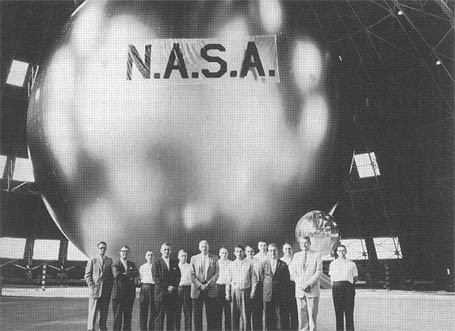COSPAR ID 1960-009A | Harvard designation 1960 Alpha 11 SATCAT no. 49 Launch mass 66 kg (146 lb) | |
 | ||
Project Echo was the first passive communications satellite experiment. Each of the two American spacecraft, launched in 1960 and 1964, was a metalized balloon satellite acting as a passive reflector of microwave signals. Communication signals were bounced off them from one point on Earth to another. :)
Contents
Echo 1
NASA's Echo 1 satellite was built by Gilmore Schjeldahl's G.T. Schjeldahl Company in Northfield, Minnesota. The balloon satellite functioned as a reflector, not a transceiver, so after it was placed in a low Earth orbit a signal could be sent to it, reflected by its surface, and returned to Earth.
During ground inflation tests, 40,000 pounds (18,000 kg) of air was needed to fill the balloon, but while in orbit, several pounds of gas were all that was required to fill the sphere. At launch the balloon weighed 156.995 pounds (71.212 kg) which included 33.34 pounds (15.12 kg) of sublimating powders of two types. The first weighing 10 pounds (4.5 kg) with a very high vapor pressure, the second with a much lower vapor pressure. According to NASA, "To keep the sphere inflated in spite of meteorite punctures and skin permeability, a make-up gas system using evaporating liquid or crystals of a subliming solid were incorporated inside the satellite."
The first attempt to orbit an Echo satellite (also the maiden voyage of the Thor-Delta launch vehicle) miscarried when Echo 1 lifted from Cape Canaveral's LC-17A on the morning of May 13, 1960. The Thor performed properly, but during the coasting phase, the attitude control jets on the unproven Delta stage failed to ignite, sending the payload into the Atlantic Ocean instead of orbit. Echo 1A (commonly referred to as just Echo 1) was put successfully into a 944-to-1,048-mile (1,519 to 1,687 km) orbit by another Thor-Delta, and a microwave transmission from the Jet Propulsion Laboratory in Pasadena, California, was received at Bell Laboratories in Holmdel, New Jersey, on August 12, 1960.
The 30.5-metre (100 ft) diameter balloon was made of 0.5-mil-thick (12.7 µm) metalized 0.2-micrometre-thick (0.00787-mil) biaxially oriented PET film ("Mylar") material, and it was used to redirect transcontinental and intercontinental telephone, radio, and television signals. The satellite also aided the calculation of atmospheric density and solar pressure due to its large area-to-mass ratio. As its shiny surface was also reflective in the range of visible light, Echo 1A was easily visible to the unaided eye over most of the Earth. The spacecraft was nicknamed a 'satelloon' by those involved in the project, as a portmanteau of satellite-balloon.
It also had 107.9 MHz beacon transmitters for telemetry purposes, powered by five nickel-cadmium batteries that were charged by 70 solar cells mounted on the balloon. During the latter portion of its life, the spacecraft was used to evaluate the technical feasibility of satellite triangulation. It had a total mass of 180 kilograms (397 lb).
Echo 1A was originally loosely estimated to survive until soon after its fourth dip into the atmosphere in July 1963 but possibly until 1964 or beyond but it ended up living much longer than these estimates and reentered Earth's atmosphere, burning up on May 24, 1968.
Echo 2
Echo 2 was a 41.1-meter-diameter (135 ft) balloon, which was the last balloon satellite launched by Project Echo. It used an improved inflation system to improve the balloon's smoothness and sphericity. It was launched January 25, 1964, on a Thor Agena rocket.
Instrumentation included a beacon telemetry system that provided a tracking signal, monitored spacecraft skin temperature between −120 and +16 °C (−184 and 61 °F), and measured the internal pressure of the spacecraft between 0.00005 mm of mercury and 0.5 mm of mercury, especially during the initial inflation stages. The system consisted of two beacon assemblies powered by solar cell panels and had a minimum power output of 45 mW at 136.02 MHz and 136.17 MHz.
In addition to the passive communications experiments, it was used to investigate the dynamics of large spacecraft and for global geometric geodesy.
Echo 2, being larger than Echo 1A and also orbiting in a near polar orbit, was conspicuously visible to the unaided eye over all of the Earth. Echo 2 reentered Earth's atmosphere and burned up on June 7, 1969.
Unlike Echo 1, Echo 2's skin was rigidizable, and the balloon was capable of maintaining its shape without a constant internal pressure. This removed the requirement for a long term supply of inflation gas, and meant that the balloon could easily survive strikes from micrometeoroids. The balloon was constructed from "a 0.35mil (9µm) thick mylar film sandwiched between two layers of 0.18 mil (4.5µm) thick aluminum foil and bonded together." The balloon was inflated to such a level as required to slightly plastically deform the metal layers of the laminate, while leaving the polymer in the elastic range. This resulted in a rigid and very smooth spherical shell.
Of note is that both the Echo 1A and Echo 2 experienced a solar sail effect due to their large size and low mass. Later passive communications satellites such as OV1-08 PasComSat solved the problems associated with this by using a grid-sphere design instead of a covered surface. Later yet, NASA abandoned passive communications systems in favor of active satellites.
Other uses
The Echo satellite program also provided the astronomical reference points required to accurately locate Moscow. This improved accuracy was sought by the US military for the purpose of targeting intercontinental ballistic missiles.
The large horn antenna at Holmdel constructed by Bell Labs for the Echo project was later used by Arno Penzias and Robert Woodrow Wilson for their Nobel Prize-winning discovery of the cosmic microwave background radiation.
Echo I commemoration
The U.S. Post office issued a postage stamp commemorating Project Echo on December 15, 1960.
